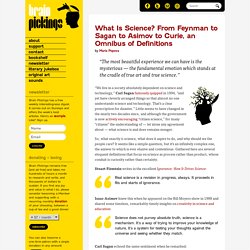

What Is Science? From Feynman to Sagan to Asimov to Curie, an Omnibus of Definitions. By Maria Popova “The most beautiful experience we can have is the mysterious — the fundamental emotion which stands at the cradle of true art and true science.”

“We live in a society absolutely dependent on science and technology,” Carl Sagan famously quipped in 1994, “and yet have cleverly arranged things so that almost no one understands science and technology. That’s a clear prescription for disaster.” Little seems to have changed in the nearly two decades since, and although the government is now actively encouraging “citizen science,” for many “citizens” the understanding of — let alone any agreement about — what science is and does remains meager. So, what exactly is science, what does it aspire to do, and why should we the people care? Stuart Firestein writes in the excellent Ignorance: How It Drives Science: Real science is a revision in progress, always. Science does not purvey absolute truth, science is a mechanism. Carl Sagan echoed the same sentiment when he remarked: Later: Laura Snyder: The Philosophical Breakfast Club.
Sci/Tech. BBC Knowledge Explainer DNA. Science Rap B.A.T.T.L.E.S. Bring Hip-Hop Into The Classroom : Code Switch. This story comes to us from our friends at the science desk.

They produced the 7-minute video documentary you see above. "Modern-day rappers — all they talk about is money, and all these unnecessary and irrelevant topics," says Victoria Richardson, a freshman at Bronx Compass High School. Richardson's rhymes tackle a much less-popular subject: DNA. Richardson and her teammates were finalists at the Science Genius B.A.T.T.L.E.S. (Bring Attention to Transforming Teaching, Learning and Engagement in Science) competition, where she faced off against other science rappers from nine different New York public schools.
"Science Genius is about harvesting the power of urban youth culture," says Christopher Emdin, a professor of education at Columbia University's Teacher's College who created the program. Tom McFadden The students researched and wrote rhymes about everything from gravity to evolution. This program is part of a national push to boost science education among minorities.
How the Science of Swarms Can Help Us Fight Cancer and Predict the Future. The first thing to hit Iain Couzin when he walked into the Oxford lab where he kept his locusts was the smell, like a stale barn full of old hay.

The second, third, and fourth things to hit him were locusts. The insects frequently escaped their cages and careened into the faces of scientists and lab techs. The room was hot and humid, and the constant commotion of 20,000 bugs produced a miasma of aerosolized insect exoskeleton. Many of the staff had to wear respirators to avoid developing severe allergies.
“It wasn’t the easiest place to do science,” Couzin says. In the mid-2000s that lab was, however, one of the only places on earth to do the kind of science Couzin wanted. Couzin would put groups of up to 120 juveniles into a sombrero-shaped arena he called the locust accelerator, letting them walk in circles around the rim for eight hours a day while an overhead camera filmed their movements and software mapped their positions and orientations. Click to Open Overlay Gallery.